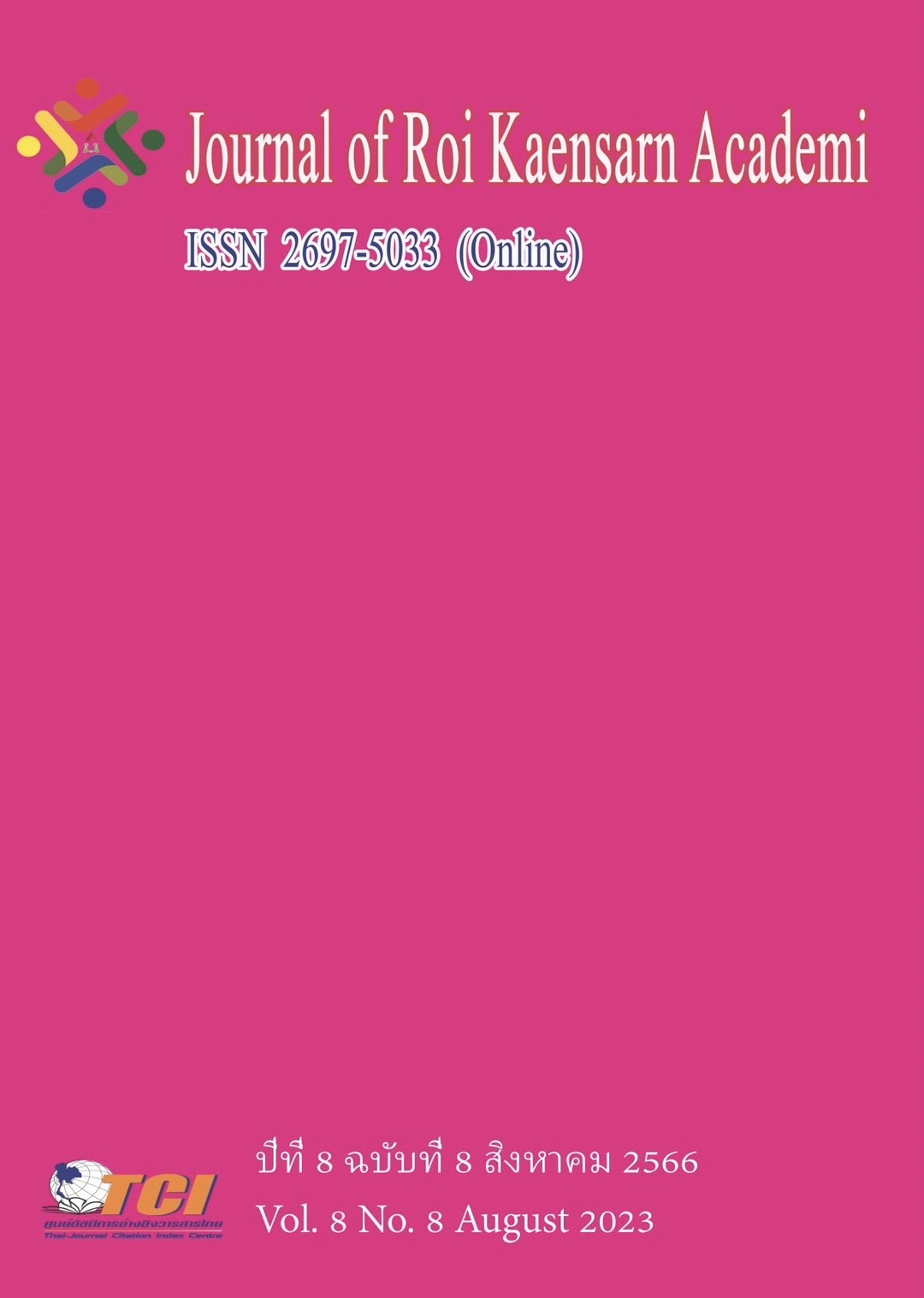ผลกระทบของกัญชาต่อผู้ขับขี่ และแนวทางการตรวจคัดกรองการใช้กัญชาในผู้ขับขี่รถสาธารณะ
Main Article Content
บทคัดย่อ
บทความวิชาการนี้มีวัตถุประสงค์เพื่อศึกษาผลกระทบของการใช้กัญชาต่อการขับขี่และเพื่อร่างแนวทางในการตรวจคัดกรองกัญชาในผู้ขับขี่รถสาธารณะ เนื่องจากกัญชานั้นมีผลกระทบต่อการตัดสินใจขณะขับขี่ พฤติกรรมการใช้รถใช้ถนนขณะขับขี่ ทำให้มีโอกาสเกิดอุบัติเหตุบนท้องถนนเพิ่มขึ้นได้ วิธีการตรวจวัดของกัญชานั้นจะแตกต่างจากการวัดแอลกอฮอล์ เนื่องจากกัญชาไม่สามารถวัดจากลมหายใจ ต้องตรวจวัดในเลือดหรือปัสสาวะเท่านั้นและอาการแสดงไม่มีความสัมพันธ์กับปริมาณที่วัดได้ในปัสสาวะ โดยแนวทางการตรวจคัดกรองการสัมผัสกัญชาในผู้ขับขี่รถสาธารณะนั้น มีมาตรการที่ต้องตระหนักคือ การสุ่มตรวจอย่างเท่าเทียม โดยไม่แจ้งให้ทราบล่วงหน้า
Article Details
เอกสารอ้างอิง
กรมควบคุมโรค. (2563). สถานการณ์และมาตรการความปลอดภัยทางถนน
ประกาศกระทรวงสาธารณสุข เรื่อง ชื่อ ประเภท ชนิด หรือลักษณะของผลิตภัณฑ์สมุนไพรที่ห้ามนำเข้า.
(2565, 2 มิถุนายน). ราชกิจจานุเบกษา. 139 ตอนพิเศษ 129 ง. 21
ประกาศกระทรวงสาธารณสุข เรื่อง ระบุชื่อยาเสพติดให้โทษในประเภท 5. (2565, 8 กุมภาพันธ์).
ราชกิจจานุเบกษา. 139 ตอนพิเศษ 35 ง. 8
ประกาศกรมอนามัย เรื่อง กำหนดหัวข้อวิชา การใช้กัญชา หรือกัญชง ในการทำ ประกอบ หรือปรุงอาหารที่ปลอดภัย ในการจัดการอบรมผู้ประกอบกิจการและผู้สัมผัสอาหาร. (2565, 25 สิงหาคม).
ราชกิจจานุเบกษา. 139 ตอนพิเศษ 198 ง. 32
อรรถสิทธิ์ ศรีสุบัติ และ สมชาย ธนะสิทธิชัย. (2562). กัญชากับการแพทย์แผนปัจจุบัน. วารสารกรมการแพทย์, 44(6), 5-8. แหล่งที่มา : https://he02.tci-thaijo.org/index.php/JDMS/article/view/244745
CFR 26.163 - Cutoff levels for drugs and drug metabolites. (n.d.). U.S. Government Publishing Office. Retrieved April 6, 2023, from https://www.govinfo.gov/app/details/CFR-2011-title10-vol1/CFR-2011-title10-vol1-sec26-163
FDA. (2022, January 5). Drugs of abuse home use test. U.S. Food and Drug Administration. Retrieved April 6, 2023, from https://www.fda.gov/medical-devices/drugs-abuse-tests/drugs-abuse-home-use-test
Aroonsrimorakot, S., Laiphrakpam, M., & Metadilogkul, O. (2020). Interdisciplinary Research Review Social, religious, recreational and medicinal usage of cannabis in India and Thailand. 43-50. doi:10.14456/jtir.2019.37
Asbridge, M., Hayden, J. A., & Cartwright, J. L. (2012). Acute cannabis consumption and motor vehicle collision risk: systematic review of observational studies and meta-analysis. BMJ, 344, e536. doi:10.1136/bmj.e536
Bhattacharyya, S., Crippa, J. A., Allen, P., Martin-Santos, R., Borgwardt, S., Fusar-Poli, P., . . . McGuire, P. K. (2012). Induction of Psychosis byΔ9-Tetrahydrocannabinol Reflects Modulation of Prefrontal and Striatal Function During Attentional Salience Processing. Archives of General Psychiatry, 69(1), 27-36. doi:10.1001/archgenpsychiatry.2011.161
Braff, D. L., Silverton, L., Saccuzzo, D. P., & Janowsky, D. S. (1981). Impaired speed of visual information processing in marijuana intoxication. Am J Psychiatry, 138(5), 613-617. doi:10.1176/ajp.138.5.613
Chayasirisobhon, S. (2020). Mechanisms of Action and Pharmacokinetics of Cannabis. Perm J, 25, 1-3. doi:10.7812/tpp/19.200
Connors, N., Kosnett, M. J., Kulig, K., Nelson, L. S., & Stolbach, A. I. (2020). ACMT Position Statement: Interpretation of Urine for Tetrahydrocannabinol Metabolites. J Med Toxicol, 16(2), 240-242. doi:10.1007/s13181-019-00753-8
Couper, F. J., Pemberton, M., Jarvis, A., Hughes, M., & Logan, B. K. (2002). Prevalence of drug use in commercial tractor-trailer drivers. J Forensic Sci, 47(3), 562-567.
Dahlgren, M. K., Sagar, K. A., Smith, R. T., Lambros, A. M., Kuppe, M. K., & Gruber, S. A. (2020). Recreational cannabis use impairs driving performance in the absence of acute intoxication. Drug Alcohol Depend, 208, 107771. doi:10.1016/j.drugalcdep.2019.107771
Department of Medical Science. (2015). Standard method for analysis of narcotics in urine
(Volume I). Bangkok, Thailand: Siriraj Medical Library.
Goullé, J. P., Saussereau, E., & Lacroix, C. (2008). [Delta-9-tetrahydrocannabinol pharmacokinetics]. Ann Pharm Fr, 66(4), 232-244. doi:10.1016/j.pharma.2008.07.006
Grotenhermen, F. (2003). Pharmacokinetics and pharmacodynamics of cannabinoids. Clin Pharmacokinet, 42(4), 327-360. doi:10.2165/00003088-200342040-00003
Huestis, M. A. (2007). Human cannabinoid pharmacokinetics. Chem Biodivers, 4(8), 1770-1804. doi:10.1002/cbdv.200790152
Iversen, L. (2003). Cannabis and the brain. Brain, 126(6), 1252-1270. doi:10.1093/brain/awg143
Kanchanabat, S., Arunpongpaisal, S., & Hurst, C. P. (2018). Development of the Thai Cannabis Risky Use Screening Test. Journal of Drug Issues, 49(1), 28-43. doi:10.1177/0022042618795635
MacAvoy, M. G., & Marks, D. F. (1975). Divided attention performance of cannabis users and non-users following cannabis and alcohol. Psychopharmacologia, 44(2), 147-152. doi:10.1007/BF00421001
Marcinkova, M., Straka, L., & Novomesky, F. (2019). Cannabis and alcohol in road traffic: an overview. Acta Medica Martiniana, 19(2), 71-77. doi:doi:10.2478/acm-2019-0010
Moeller, K., Kissack, J., Atayee, R., & Lee, K. (2017). Clinical Interpretation of Urine Drug Tests. Mayo Clinic Proceedings, 92. doi:10.1016/j.mayocp.2016.12.007
Moeller, K. E., Lee, K. C., & Kissack, J. C. (2008). Urine drug screening: practical guide for clinicians. Mayo Clinic Proceedings, 83(1), 66-76. doi:10.4065/83.1.66
Mura, P., Kintz, P., Dumestre, V., Raul, S., & Hauet, T. (2005). THC can be detected in brain while absent in blood. J Anal Toxicol, 29(8), 842-843. doi:10.1093/jat/29.8.842
Nahas, G. G., Frick, H. C., Lattimer, J. K., Latour, C., & Harvey, D. (2002). Pharmacokinetics of THC in brain and testis, male gametotoxicity and premature apoptosis of spermatozoa. Hum Psychopharmacol, 17(2), 103-113. doi:10.1002/hup.369
Navarro, J., Reynaud, E., & Osiurak, F. (2018). Neuroergonomics of car driving: A critical meta-analysis of neuroimaging data on the human brain behind the wheel. Neurosci Biobehav Rev, 95, 464-479. doi:10.1016/j.neubiorev.2018.10.016
Noble, M. J., Hedberg, K., & Hendrickson, R. G. (2019). Acute cannabis toxicity. Clin Toxicol (Phila), 57(8), 735-742. doi:10.1080/15563650.2018.1548708
O'Leary, D. S., Block, R. I., Turner, B. M., Koeppel, J., Magnotta, V. A., Ponto, L. B., . . . Andreasen, N. C. (2003). Marijuana alters the human cerebellar clock. Neuroreport, 14(8), 1145-1151. Retrieved from https://journals.lww.com/neuroreport/Fulltext/2003/06110/Marijuana_
alters_the_human_cerebellar_clock.9.aspx
Peleg, K., Gopher, A., Jaffe, D. H., Siman-Tov, M., & Almog, S. (2010). Comparison of blood alcohol levels with breath alcohol levels measured using the Drager 7110 MKIII breathalyzer. Injury Prevention, 16(Suppl 1), A147. doi:10.1136/ip.2010.029215.529
Ramaekers, J. G., Kauert, G., van Ruitenbeek, P., Theunissen, E. L., Schneider, E., & Moeller, M. R. (2006). High-Potency Marijuana Impairs Executive Function and Inhibitory Motor Control. Neuropsychopharmacology, 31(10), 2296-2303. doi:10.1038/sj.npp.1301068
Saitman, A., Park, H.-D., & Fitzgerald, R. L. (2014). False-positive interferences of common urine drug screen immunoassays: a review. Journal of analytical toxicology, 38(7), 387-396. doi:10.1093/jat/bku075
Schulze, H., Schumacher, M., Urmeew, R., Alvarez, J., Bernhoft, I. M., de Gier, H. d. G., . . . Zlender, B. (2012). Driving Under the Influence of Drugs, Alcohol and Medicines in Europe — findings from the DRUID project: European Monitoring Centre for Drugs.
Spiers, H. J., & Maguire, E. A. (2007). Neural substrates of driving behaviour. Neuroimage, 36(1), 245-255. doi:10.1016/j.neuroimage.2007.02.032
Surasak Im-iam, Sarannat Saensanor, and, P. S., & Sawasdichai, C. (2019). Cannabis. The Journal of Prapokklao Hospital Clinical Medical Education Center, 36(4), 7. Retrieved from https://he02.tci-thaijo.org/index.php/ppkjournal/article/view/228729/155657
Wall, M. E., Sadler, B. M., Brine, D., Taylor, H., & Perez-Reyes, M. (1983). Metabolism, disposition, and kinetics of delta-9-tetrahydrocannabinol in men and women. Clin Pharmacol Ther, 34(3), 352-363. doi:10.1038/clpt.1983.179
U.S. Department of Transportation. (n.d.). 49 CFR § 382 - Controlled substances and alcohol use
and testing. Legal Information Institute. Retrieved April 6, 2023, Retrieve from

